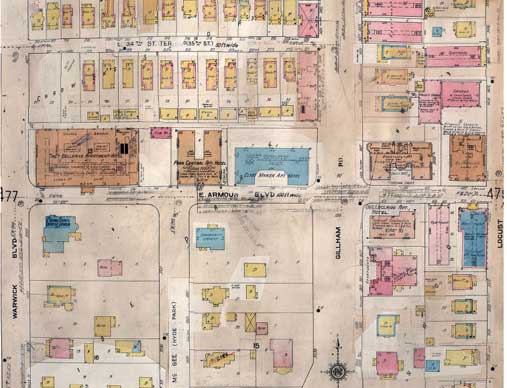
The 1950 Sanborn map shows the Catholic Community Library across the street from the Park Central Apartments on Armour Boulevard (in blue just south of Armour). Also gone are a row of single-family homes behind the Park Central, the Belleclaire Apartments at the southeast corner of Armour and Gillham and the four single-family homes between what is now the Cornerstones of Care office complex facing south toward Hyde Park.
Republished from the Feb. 2013 Hyde Parker newsletter
The large home at 301 East Armour Boulevard was demolished in 1967, but the legacy of the Lillis family who lived there remains an important part of Kansas City history.
Irish immigrant and homeowner James Lillis built the first streetcars in Kansas City as a railroad contractor, and one of his 11 children became Bishop Thomas F. Lillis, the region’s Roman Catholic leader from February 1913 to 1938. The bishop shaped local education, community service and culture, and made a positive difference in global ways.
In 1912, just four years after Westport High School was built, Bishop Lillis wrote a letter to a order of nuns in France asking them to open a new school here that became Notre Dame de Sion on Locust Street. After the groundbreaking for the National World War I Memorial on Nov. 1, 1921, it was at Bishop Lillis’ house where top Allied generals from around the world gathered for a reception.
“He was big and likeable and loved people,” Bishop Lillis’ nephew, another James Lillis, told The Catholic Key newspaper several years ago before his death at age 80 in 2011. “Every week he would throw a party or dinner at the family home and invited civic leaders. He wielded great influence.”
Bishop Lillis’ support helped build many parishes in Kansas City including St. James in South Hyde Park. He rose in the Catholic Church hierarchy and was active in national efforts to stop lynching and discrimination against African-Americans. Lillis drafted an anti-lynching condemnation document that he got his fellow bishops across the country to sign in 1933.
Lillis also became a special assistant to the Vatican, and on Oct. 24, 1936, met with Cardinal Eugenio Pacelli at the Kansas City downtown airport. Pacelli, who a few months later would become Pope Pius XII, was on his way to Hyde Park, N.Y. as part of a first-of-its-kind nationwide flying tour.
Pacelli would meet with President Franklin Roosevelt the day after the 1936 election to discuss the rising impact of fascism in Europe.
A home that became a library
After Lillis’ death at age 77 in 1988, the newly-constructed Bishop Lillis High School on Forest Avenue was named in his honor. Lillis’ Armour home, meanwhile, was converted into the 25,600 volume Catholic Community Library, which operated on Armour from 1944 until 1966. At its height, it had more than 40,000 patrons and held public workshops, classes, book club meetings and a national guest speaker series similar to what the Kansas City Public Library does today at the Truman Forum.
In the 1960s, a plan to merge the library with Rockhurst University’s library was rejected and the library closed in 1969 for lack of funding, its last home being what is now Cristo Rey High School on Linwood Boulevard.
The developer who purchased Lillis’ Armour home in 1967 tore it, its carriage house and several surrounding properties down and erected the Gilliam Plaza office building and its now deteriorating parking garage. In the past several years, it has lost office tenants such as the Housing Authority of Kansas City and the Catholic Archdiocese. Remaining tenants include a drug and alcohol rehabilitation center.
Editor’s note: A special thanks to the Archives Office of the Archdiocese of Kansas City-St. Joseph on 9th Street for their assistance in researching this story.



Who’s talking